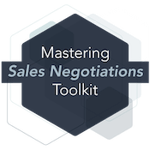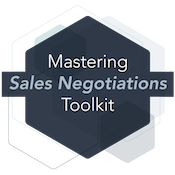Some buyers are conditioned to try certain tactics to lower your price. Maybe they've read about negotiation in books or were trained to use pressuring strategies.
When buyers take this kind of positional and win-lose approach, their goal is generally to gain the most for themselves at the expense of the seller. For example, savvy buyers know that many sellers will be especially vulnerable to manipulation just when a contract is about to be signed.
If you’ve invested hours into building rapport and value for your buyer, it can be frustrating when they suddenly turn around right at the finish line and ask for more.
It's tempting at this point for the seller to give the buyer what they want and lower the price instead of digging deeper to uncover if their concerns are valid or a bluff. But an experienced seller can take steps to protect their own interests while maintaining their relationship with a buyer.
And even a minor compromise may have far-reaching consequences. A minor discount can lead to reduced margins and create an expectation of further concessions for the buyer. Contrary to common sales philosophy, a win-win approach is not always correct.
Striking back against buyer demands is not the answer either. It’s not easy to respond productively to price pushback. However, if you can recognize negotiation tactics beforehand, you’re more likely to bring a buyer on board and get them to collaborate with you further.
Read Now: [Article + Infographic] 16 Tactics Buyers Use in Sales Negotiations
Here are some common negotiation tactics buyers might use to gain a positional advantage, and ideas for how to respond.
How Do Buyers Negotiate Price?
- Anchoring: The buyer suggests a target price to anchor the bargaining range.
- Whack Back: The buyer pushes back on the first price offered.
- Sticker Shock: The buyer is surprised or taken aback by the price you've offered.
- Cherry Picking: The buyer unbundles a solution in order to gain concessions.
- Pencil Sharpening: The buyer primes the seller into accepting a price drop.
- Going, Going, Gone: The buyer creates a sense of urgency, even threatening to leave entirely.
-
1. Anchoring
Buyer says: "We're looking to spend no more than $500,000 for this."
-
With this tactic, the buyer shares a target price, such as a budget cap, to anchor the bargaining range.
How to respond: Ideally, you should be the first to suggest a price—in fact, taking the lead is one of the 6 essential rules of negotiation. Don't wait for the buyer to do so. If that doesn't work out, don't accept their number at face value. Ask how they came up with their number, and how it fits with their budget. The goal is to uncover whether it's a real number or a ploy. -
Come to negotiations prepared with an understanding of what their possible alternatives are (their BATNA), as well as your own. Don’t just drop your price because they set the anchor. As always, being willing to walk is one of the most powerful things you can do in negotiation.
2. Whack Back
Buyer says: "Your price is too high," no matter what it is when you tell them for the first time.
-
This is one of the most common buyer tactics—to ALWAYS push back on the first price offered.
How to respond: Ask why. Listen fully as the buyer explains their objection, and ask permission to completely understand the issue. What they say will dictate your response. For example, if they say, "Well, I've bought it before for X!" You can say, "I think the reason I'm here is that you've had a lot of problems in the past. We're different than X." And so on.
Often, money objections aren’t truly about money at all. Understand that buyers may open with this pushback because they’ve learned that it works. It’s up to you to build the value of your solution. If you focus on the buyer’s objectives, you can usually come up with ideas to build value without lowering price. - Further Reading: 4 Steps to Overcoming Sales Objections >>
3. Sticker Shock
Buyer says: "It costs how much?!"
-
The buyer appears to be shocked or stumped by the price you've offered. It could be an orchestrated reaction, rather than genuine surprise.
How to respond: Ignore their flinch and wait for any theatrics to die down. Ask why it seems high to them. Often their reasoning is faulty, and you can open up a conversation based on what you find out.
In this type of price pushback situation, it’s important for you to help buyers understand the positive impact your solution will have on them so they can justify the investment.
4. Cherry Picking
Buyer says: "I know I told you our initial order would be 5,000 units with 5 components, but we'll just need 500 units and 2 components at first. I did the division so the price should be..."
-
In this scenario, the buyer has tried to unbundle a solution to gain concessions and assumed the unit price will stay the same.
How to respond: Address the issue head on with a statement such as "I'll need to review the pricing based on the new scope and terms." They may make it seem as though these new terms came out of nowhere and nothing can be done, but remember—you don't have to accept changed terms just because the buyer changed them. Engage in a discussion to work out appropriate pricing.
5. Pencil Sharpening
Buyer says: "You're going to have to do better than this. We need to get it for less."
-
This is a common pushback tactic to "get you ready" to drop your price because it's "expected." Sometimes, the buyer may offer to close at a lower price for a period of time until value is established.
How to respond: Don't ask "Well, where do we need to be?" This is a trap. Focus instead on asking questions such as, "Why?" and "What are you comparing us to?" Hold your ground on differentiating the value you offer. If you probe to create solutions, the buyer will often back down.
Focus on what makes your solution the best choice, have value-adds ready to bargain, and be prepared to trade, not cave.
6. Going, Going, Gone
Buyer says: "I will give it to a competitor by noon if you don't make this concession."
-
This tactic uses time pressure to get the seller to lower their price.
How to respond: Don't panic or reflexively drop the price. Stall for time to think. Ask for a few minutes to disengage, saying something like, "I'm in the middle of something else right now. I can take a look soon and call you back."
Alternatively, you can ask, "So we'll know one way or another after your meeting?" If the buyer says no, then it could be a bluff. If it's a yes, take time to think and call back with a bargain you want. But be aware that this can be a power play on their part. If you cave, they'll expect it in the future.
How to Prepare for a Price Negotiation
Beyond recognizing the tactics, prepare yourself to handle price objections by following the 6 Essential Rules of Sales Negotiation.
1. Build value
2. Lead the negotiation
3. Effect emotions
4. Trade. Don’t cave
5. Plan to Win
6. Always be willing to walk
Recognize tactics and be ready
Now that you can identify these buyer tactics, prepare for your next negotiation by giving some thought to how you will respond if any arise. It's your job to dig deeper into the real issues, separating the buyer's valid concerns from their bluffs and manipulations.Always keep in mind that, while you shouldn’t make concessions, you can make trades. Good sellers are willing to change scope or explore other possibilities rather than just altering price. Even if you find you have to lower your price, never give anything away for free. This is why “Trade, Don’t Cave” is one of the top negotiation strategies used by sellers.
The strength of your negotiating lies in the value you provide—by being able to listen, articulate value, and collaborate on a solution, you can dispel buyer objections and lead strong negotiations.








